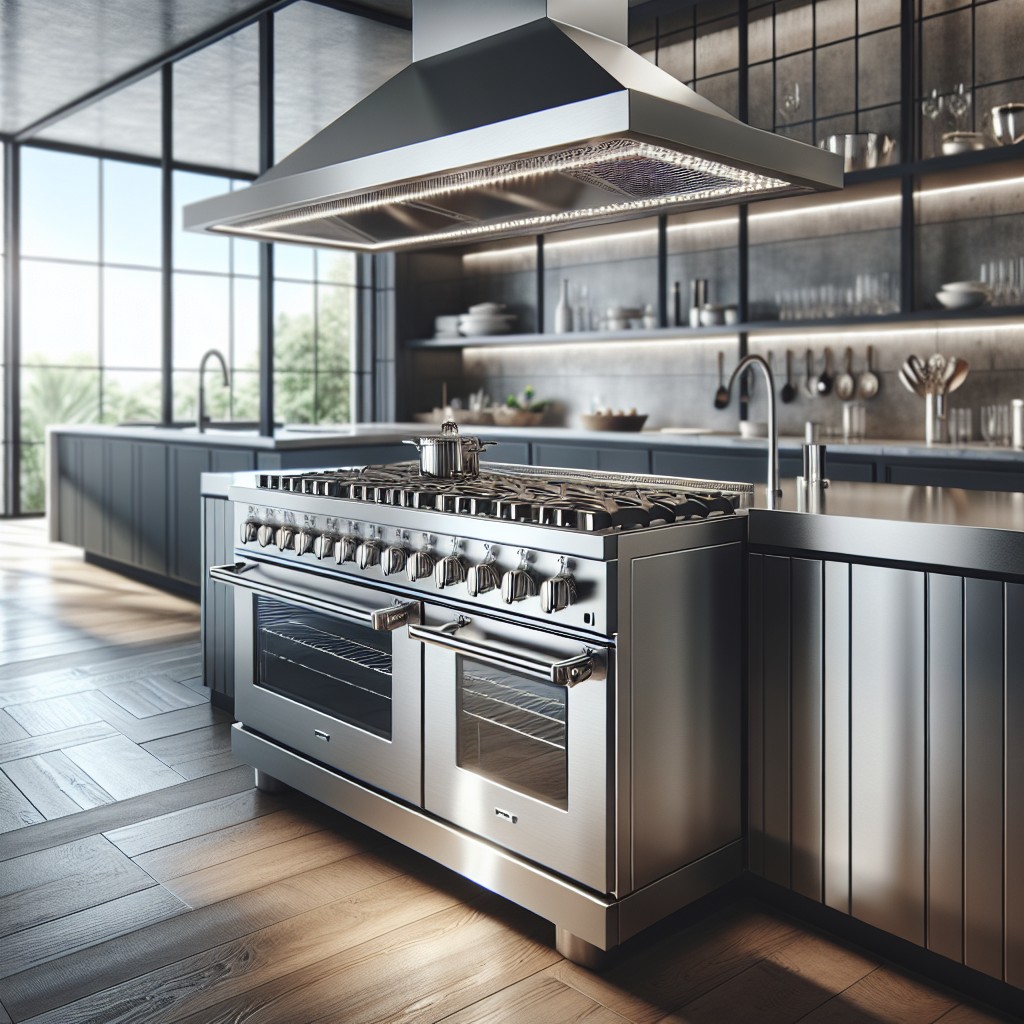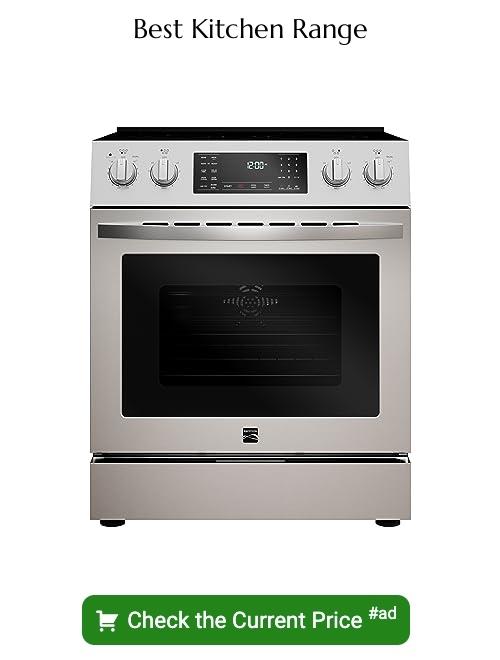Last updated on
A range in a kitchen is considerably more than just an appliance; it’s the cornerstone of food preparation in your home, and this article will provide in-depth understanding of its function, types, and benefits.
Key takeaways:
- A kitchen range combines a stovetop and an oven.
- Range types include gas, electric, dual fuel, induction, slide-in, freestanding, and pro-style.
- Key range features include burner configuration, oven capacity, convection cooking, self-cleaning, control panel, and safety features.
- Choose a range that aligns with your cooking style and preferences.
- Consider range installation factors such as ventilation, workspace management, safety clearance, accessibility to gas or electric, and traffic flow.
What's Inside
Range Definition and Function

A kitchen range is the workhorse of the cooking space, serving two primary functions: a stovetop for simmering, sautéing, boiling, and frying; and an oven for baking, roasting, and broiling. This essential appliance combines a cooktop, with varying numbers of burners or heating elements, and an oven, essentially packing multiple cooking methods into one cohesive unit.
The convenience of a range lies in its centralized design, allowing cooks to manage an array of culinary tasks without needing to move between separate appliances. Whether you’re flipping pancakes on the griddle or perfecting a roast in the oven, the range is a pivotal tool for both novice cooks and seasoned chefs alike, facilitating a seamless cooking experience.
Essential Range Types
When selecting a kitchen range, you’re typically looking at two fuel options: gas or electric. Gas ranges offer precise heat control and faster heating, while electric ranges provide even baking and are often easier to clean. There’s also a dual fuel option combining a gas cooktop with an electric oven, bringing together the best of both worlds.
For those with a passion for modern technology and convenience, induction ranges are a standout, offering speedy and responsive heat control using an electromagnetic field. However, they require compatible cookware to function.
For space-saving solutions, consider slide-in models that fit seamlessly between cabinets. Freestanding ranges, on the other hand, have finished sides and can stand alone, making them versatile in placement. Lastly, if you’re designing a high-end kitchen or wish to mimic a professional cooking environment, there’s the pro-style range, boasting high-power burners, larger capacities, and a robust build.
With options abound, focus on the features that blend with your culinary needs and kitchen operation. Each type offers distinct advantages, ensuring there’s a range suited to every home chef’s taste.
Key Range Features
Different ranges come equipped with a variety of features designed to meet various culinary needs and preferences. Let’s break down some of these key offerings:
- Burner Configuration: Options typically include standard four-burner models, but many showcase a fifth burner for keeping dishes warm or additional cooking space. High-end variants even offer customizable burner arrangements and specialized functions like wok burners or griddle plates.
- Oven Capacity: Size matters when it comes to ovens. Larger ovens accommodate big roasts or multiple dishes, whereas smaller ones are sufficient for everyday cooking and can be more energy-efficient for singles or couples.
- Convection Cooking: An invaluable feature for those who take their baking and roasting seriously. Convection fans circulate hot air for a more even and faster cooking process — a real game-changer for consistent browning and reducing cook times.
- Self-Cleaning: A convenience feature that enables the oven to heat high enough to incinerate food residue, turning spills and splatters into ash that’s easily wiped away, sparing you the effort of intense scrubbing.
- Control Panel: The brain of the range. Modern touch screens offer intuitive control, while traditional dials provide tactile feedback. Some ranges now integrate smart functions for remote control and monitoring via smartphone.
- Safety Features: Child safety locks, automatic shut-off, and cool-to-touch doors offer peace of mind, especially for families with young children or individuals who are prone to distraction.
Each feature serves a purpose and caters to different lifestyles and cooking habits. Reflect on your culinary routine to recognize which features align with your daily practices and which might be enjoyable upgrades to your cooking arsenal.
Choosing the Right Range for Your Cooking Style
When selecting a range, align your choice with your culinary habits and preferences. If you’re a casual cook who appreciates convenience, consider a standard gas or electric range with simple controls and consistent temperatures. Should baking and roasts be your forte, opt for a range with accurate temperature control and convection options, which circulate air for even cooking.
For ambitious cooks aiming for restaurant-quality results, high-end gas ranges with multiple burners and higher BTUs provide the firepower needed for quick searing and simmering. Meanwhile, induction ranges offer precise heat control and energy efficiency—ideal for those mindful of sustainable cooking practices.
If you dabble in both everyday meals and complex cuisines, dual-fuel ranges might be the perfect choice. They combine the responsiveness of a gas cooktop with an electric oven’s steady heat—granting flexibility to tackle a variety of dishes efficiently.
Remember to take into account the maintenance and cleaning ease; flat-top electric ranges often make cleanup a breeze, while gas ranges might demand more elbow grease due to grates and burners.
In essence, consider how the range will match your cooking style, whether it’s low-maintenance meals or gastronomic adventures, to enhance your kitchen experience.
Range Installation Considerations for Kitchen Layout
Efficient kitchen design hinges on optimal range placement. Here are vital points to ensure your range installation complements your kitchen layout:
- Proximity to Ventilation: Position your range where there’s access to a range hood or exhaust fan, striking a balance between removing odors and grease while maintaining airflow.
- Workspace Management: Allow for ample counter space on either side of the range. This creates a safe area for prepping and placing hot dishes, streamlining your cooking process.
- Safety Clearance: Adhere to safety codes by maintaining the required distance between the range and flammable materials, including curtains, cabinets, and utensils.
- Gas or Electric Accessibility: Ensure that the location of your range is near the appropriate power source. For gas ranges, there must be a gas line; for electric ranges, a suitable power outlet is needed.
- Traffic Flow: Avoid placing the range in high-traffic areas to reduce the risk of accidents. The range should be easily accessible without interrupting the flow of the kitchen.
By mindfully considering these practical installation guidelines, you can enhance both the function and safety of your kitchen space.





